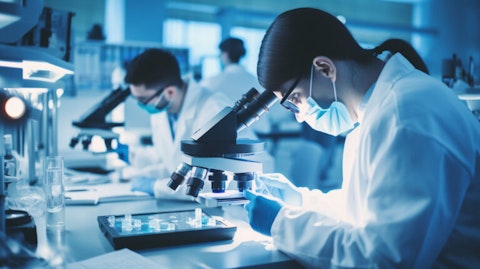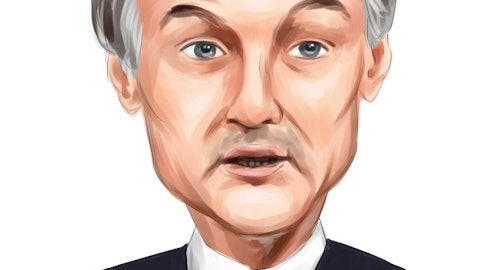Humacyte, Inc. (NASDAQ:HUMA) Q3 2023 Earnings Call Transcript November 10, 2023
Operator: Good afternoon, ladies and gentlemen, and welcome to the Humacyte Third Quarter Results Conference Call. Currently, all participants are in a listen-only mode. Later, we will conduct a question-and-answer session, and instructions will follow at that time. As a reminder, this conference call is being recorded. I will now turn the call over to Lauren Marek with LifeSci Advisors. Please go ahead.
Lauren Marek: Thank you, operator. Before we proceed with the call, I would like to remind everyone that certain statements made during this call are forward-looking statements under U.S. federal securities laws. These statements are subject to risks and uncertainties that could cause actual results to differ materially from historical experience or present expectations. Additional information concerning factors that could cause actual results to differ from statements made on this call is contained in our periodic reports filed with the SEC. The forward-looking statements made during this call speak only as of the date hereof, and the company undertakes no obligation to update or revise the forward-looking statements, except as required by law.
Information presented on this call is contained in the press release we issued this afternoon and in our Form 10-Q, which after filing may be accessed from the Investors page of the Humacyte website. Joining me on today’s call from Humacyte are Dr. Laura Niklason, President and Chief Executive Officer; Dale Sander, Chief Financial Officer and Chief Corporate Development Officer; and Dr. Heather Prichard, Chief Operating Officer. Dr. Niklason will provide a summary of the company’s progress during the quarter and recent weeks, and Dale will review the company’s financial results for the quarter ended September 30, 2023. Following their prepared remarks, the management team will be available for your questions. I will now turn the call over to Dr. Niklason.
Laura Niklason: Thank you, Lauren. Good afternoon, everyone, and thank you for joining us for our third quarter 2023 financial results and business update call. Our third quarter was a highly productive period for Humacyte, during which we achieved significant milestones in the advancement of our universally implantable bioengineered human tissue product candidate the Human Acellular Vessel, or HAV, and we’ve worked on this in multiple indications. This was led by our announcement in September of positive top line results from our Phase 2/3 clinical trial in vascular trauma repair, which positions us to submit our BLA filing for approval in this indication during the current quarter. We’re also pleased that potential of our HAV pipeline has been shown in other clinical studies this quarter, including the presentation of Phase 2 results in severe Peripheral Artery Disease, or PAD.
In addition, we recently published preclinical results of our small caliber HAV in a juvenile heart disease model. During today’s call, I’ll review these recent highlights in more detail before turning the call over to Dale for a review of our financial results, then we’ll be happy to open the call to your questions. I’ll begin with our HAV program in vascular trauma and the positive top line results that we announced from our V005 Phase 2/3 clinical trial of the HAV in trauma repair. In this clinical trial, the HAV had higher rates of patency and lower rates of amputation and infection as compared to historical published benchmarks of synthetic graft function in trauma patients. A total of 69 patients were enrolled in the V005 trial, and 51 of these had vascular injury of the extremities and comprise the primary evaluation group for the study.
The 30-day patency or presence of blood flow for the HAV in the clinical trial was 90% as compared to approximately 81% historically reported for synthetic graphs. Importantly, the HAV also demonstrated lower amputation rate with a rate of 9.8% for the HAV as compared to over 20% being reported historically for synthetic graft. This means that for a vascular trauma patient receiving the HAV, the chances of amputation are less than half of the chances associated with receiving a synthetic graft. It’s also important to note that in the V005 trial, there were no amputations that occurred because of failure of HAV. All of the amputations occurred because of severe injuries to the limb and not due to loss of blood flow from the HAV implant. The HAV also demonstrated lower rates of infection, with an infection rate of 2% compared to over 8% historically reported for synthetic graft.
In other words, patients receiving the HAV in this trial were less than half is likely to suffer an amputation, and one-fourth is likely to have an infection of their graft as patients who historically got synthetic graphs for their injuries. Building on the momentum of these positive results, we plan to submit a Biologics Licensing Application, or BLA, with the FDA during this quarter. In May of this year, Humacyte received a Regenerative Medicine Advanced Therapy, or RMAT, designation from the FDA, which will allow us to request a priority review of our BLA filing. Since we’ve also received priority designation from the Department of Defense, we believe that we’ll have a high potential for priority review of our planned BLA filing in the trauma indication.
Further buttressing the real-world utility of the HAV in treating injured patients, Humacyte’s vessels have been used in Ukraine under humanitarian aid program. During the one-year humanitarian effort, 19 vascular trauma patients received the HAV in Ukraine. Results will also be highlighted from these patients in our BLA filing with the FDA. Outcomes from these 19 patients were described in a presentation at the 2023 Military Health System Research Symposium in August, with clinicians reporting a very high success rate in treating these patients with the HAV to date. In war wounded patients in Ukraine, who suffered blast and shrapnel injuries that were often severe, both a 30-day limb salvage and 30-day patient survival were 100%. 30-day patency or blood flow was 95%, and there were no reported instances of infection of the HAV.
We believe that these remarkable results are an important addition to our BLA filing, and we’re proud to be able to help our Ukrainian surgeon colleagues, save life and limb in this wartime setting. Humacyte and our collaborators expect to make multiple presentations at the VEITH Symposium, which is a major vascular surgery meeting in New York next week. These include an expanded presentation of the results of our V005 vascular trauma trial. And also the outcome of research, which seeks to identify which dialysis patients experience the most difficulties with their dialysis access and which patients may benefit from an access that is both durable and resistant infection. In September, clinical results were also presented on an FDA-regulated investigator-sponsored clinical study at the Mayo Clinic.
In this study, patients with severe peripheral arterial disease, who face possible limb amputation and who had no vein of their own for bypass surgery, were treated with the HAV to restore blood flow to their limbs. In the presentation at the Midwestern Vascular Conference, Mayo researchers observed that the HAV was a safe, resilient and effective conduit for arterial bypass and limb salvage. This is an important result since approximately 40% of patients requiring lower extremity bypass do not have saphenous vein available. In the future, the HAV may represent a promising alternative for preserving limbs in patients with advanced peripheral artery disease. With regard to publications, in October of 2023, a publication in the Journal of Thoracic and Cardiovascular Surgery described a preclinical study showing the potential for the investigational small diameter HAV to treat Tetralogy of Fallot, which is a heart condition that affects one in every 2,000 babies born each year.
In this large animal study, Humacyte collaborated with researchers from Nationwide Children’s Hospital in Columbus, Ohio to implant 3.5-millimeter HAVs into a juvenile model of pediatric heart surgery. The 3.5-millimeter HAVs remained patent for up to six months and showed evidence of repopulation by host cells, which was similar to what’s been observed in human patients. This study also demonstrated the extension of Humacyte manufacturing platform, adding production of 3.5-millimeter vessels in the same platform that is used to produce Humacyte 6-millimeter HAVs, which are the ones that are in current clinical use. In July, results from a preclinical study on the ability of the HAV to resist infection were published in the Journal of Vascular Surgery-Vascular Science.
This study provides a scientific basis for the low rates of infection that we have observed in clinical trials of the HAV to date. Researchers found that compared to synthetic grafts, the HAV had a significantly lower bacterial infection rate. This infection resistance of the HAV may be due to the native-like biocompatibility of the HAV material, which supports the survival and function of human immune cells that are the key to fighting bacterial infection. These results have broad implications for all of our intended clinical indications and further support the potential of the HAV as an excellent alternative to synthetic graphs in a wide range of medical conditions. And with that, I’ll now turn it over to Dale for a review of our financial results and other business developments.
Dale Sander: Thank you, Laura. As of September 30, 2023, we had cash and cash equivalents of $100 million. In May 2023, we reported the completion of a funding arrangement with Oberland Capital of up to $160 million, of which we have received $40 million to date. Total net cash used was $49.4 million for the first nine months of 2023, compared to $53.8 million for the first nine months of 2022. We believe that our cash and cash equivalents and expected funding from the Oberland funding arrangement are adequate finance operations passed the currently anticipated timelines for FDA approval and commercialization of HIV in the vascular trauma indication. There was no revenue for the third quarter of 2023 and nine months ended September 30, 2023.
Revenues were $31,000 for the third quarter of 2022 and $1.6 million for the nine months ended September 30, 2022. Revenue from 2022 was related to a grant supporting the development of HAV. Research and development expenses were $18.6 million for the third quarter of 2023 compared to $17.3 million for the third quarter of 2022, and were $56.4 million for the nine months ended September 30, 2023 compared to $48.3 million for the nine months ended September 30, 2022. The current period increases resulted primarily from increased personnel and external services to support expanded research and development initiatives and our clinical trials, including preparation for the HAV trauma clinical trial and completion and planned BLA filing for the vascular trauma indication and expansion of clinical development of HAV in AV access for hemodialysis.
General and administrative expenses were $6.1 million for the third quarter of 2023 compared to $6.2 million for the third quarter of 2022, and were $17.5 million for the nine months ended September 30, 2023, compared to $17.1 million for the nine months ended September 30, 2022. The increase during the 9 months ended September 30, 2020, compared to the prior-year period resulted primarily from increased personnel costs, largely driven by preparation for the planned U.S. commercial launch of HAV in the vascular trauma indication. The slight decrease during the third quarter of 2023 compared to 2022 resulted primarily from a reduction in external services and professional fees, partially offset by an increase in personnel expenses. Other net income or expense was a net expense of $1.4 million for the third quarter of 2023 compared to a net expense of $1.8 million for the third quarter of 2022.
And other net expense was $11.8 million for the nine months ended September 30, 2023, compared to other net income of $55.5 million for the nine months ended September 30, 2022. The decrease in other net expenses for the third quarter of 2023 compared to 2022 resulted primarily from an increase in interest income due to rate increases. The increase in other net expense for the nine months ending September 30, 2023 compared to 2022 resulted primarily from the non-cash remeasurement of the contingent earnout liability associated with the 2021 merger with Alpha Healthcare Acquisition Corp. Net loss was $26.0 million for the third quarter of 2023 compared to $25.3 million for the third quarter of 2022. And net loss was $85.7 million for the nine months ended September 30, 2023 compared to $8.2 million for the nine months ended September 30, 2022.
The current period increase in net loss resulted from the non-cash measurement of the contingent earnout liability and increased operating expenses described with that. With that, I’ll turn it back over to Laura for concluding remarks.
Laura Niklason: Thank you, Dale. This is a very exciting time for Humacyte and for all of our stakeholders. As we move closer to our planned regulatory filing in our first HAV indication, I’d like to take a moment to thank the entire Humacyte team as well as our partners for their continued commitments to our programs. The entire team has worked incredibly hard to reach this point, and we are approaching what could be a transformational time not only for the company, but for patients who are suffering from a variety of vascular diseases. Across our clinical programs, the HAV has already accumulated more than 1,200 patient years of experience, including in vascular trauma, vascular access and hemodialysis and peripheral artery disease.
We’re also continuing to study the HAV in our earlier-stage programs in order to maximize the full potential of the HAV’s value for our patients and for our investors. We look forward to keeping you updated on our progress, and thank you all for joining us today. Operator, we’re now ready to take questions.
Operator: [Operator Instructions] Our first question comes from Suraj Kalia of Oppenheimer. Your line is open.
Suraj Kalia: Hi, Laura, Dale. Can you hear me all right?
See also 20 Wealthiest States in America and 30 Biggest Private Equity Companies By AUM.
Q&A Session
Follow Humacyte Inc.
Follow Humacyte Inc.
Laura Niklason: Yes, we can.
Suraj Kalia: Perfect. Congrats on all the progress. Laura at VEITH, what additional data on V005 should we expect?
Laura Niklason: At the VEITH meeting, we’re going to share, in addition to the efficacy results, we’re going to share some of the safety outcomes. That’s during a podium presentation that will occur during the meeting on Wednesday. In addition, on Thursday evening, we have a dinner symposium session where we will talk about the V005 outcomes and also the outcomes from Ukraine and look at the combination of those outcomes and as they compare to our benchmarks in synthetic graft treatment for vascular trauma.
Suraj Kalia: Got it. Laura, assuming nine months post BLA filing for a vascular trauma indication, how should we start thinking about — my understanding is the label would be sort of not indicated for synthetic grafts. So, can you size up the market and also the low-hanging fruit post approval?
Laura Niklason: So, I think in terms of the size of the market, as we’ve shared in earlier presentations, there’s approximately 70,000 vascular injuries in the U.S. that occur every year that require some sort of repair, and tens of thousands of those probably require grafting or active surgical repair. So, of those, about 12% or 15% are done with synthetic grafts. But if you talk to trauma surgeons and if you look at the literature, essentially all traumatic injuries are viewed as being contaminated or potentially contaminated and infected. So, if you — again, if you talk to trauma practitioners, they will tell you that synthetic grafts are essentially never indicated in patients with traumatic injury. In addition, we believe that in many cases, the extra hour that it takes to harvest vein is going to make many patients who might have otherwise gotten a vein be more suitable for an HAV, because the extra hour that it takes to harvest the vein puts the injured limb at increased risk of amputation.
So, we believe that we will take a sizable fraction of certainly the synthetic graft use, but also we believe we’ll eat into vein use as well in the traumatic injury indication.
Dale Sander: And Suraj, some of the data that may will be presented at VEITH will be the outcome from the study in terms of why surgeons use the HAV in those particular patients and that may provide some further evidence to support what Laura just said about the likely uses and why they would choose to use it in certain instances over synthetic or saphenous vein?
Suraj Kalia: Got it. Appreciate the additional color. Dale, one final question for you. Dale, the contingent earnout in revenue interest liability caught my attention. Love some additional color. I’m assuming the revenue interest liability is the $40 million from Oberland, but I might be wrong, if you could just walk us through that? Thank you.
Dale Sander: Yeah, you’re exactly right. The — what we call the RIP, or the Revenue Interest Liability, is essentially the debt instrument with Oberland. And so, that will accrue up over time as interest is accrued. But right now, the face amount of that debt is $40 million. The contingent earnout liabilities associated with our going public transaction, the legacy holders of Humacyte are potentially due shares if the stock price hits certain levels. And so, every quarter, if the price goes down, that liability increases and there’s a non-cash expense recorded and if the stock goes down that quarter, there’s a non-cash gain and the liability goes down.
Suraj Kalia: Got it. Thank you so much for taking my questions.
Operator: Our next question comes from Josh Jennings of TD Cowen. Your line is open.
Unidentified Analyst: Hi. This is Eric on for Josh. Thanks for taking the question. On the RMAT designation that you have in vascular trauma, I was wondering if you could share with us when you will know whether or not you received priority review for your BLA filing. And secondly, if you do receive prior to review, could you specify what that entitles you to throughout the BLA review process? Thank you.




